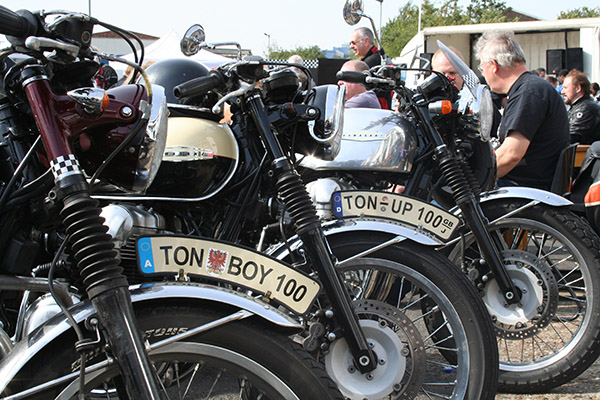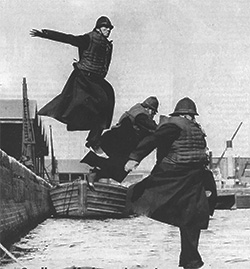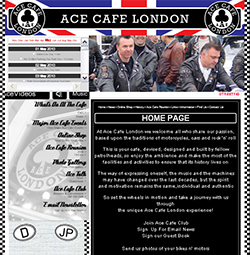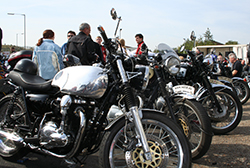 United Kingdom – The Ace Café may be a Mecca for the motorcyclist but in 1967 the ‘Ace’ and in particular the Grand Union Canal running behind it, once took on a different & more sinister tale of motorcycling.
United Kingdom – The Ace Café may be a Mecca for the motorcyclist but in 1967 the ‘Ace’ and in particular the Grand Union Canal running behind it, once took on a different & more sinister tale of motorcycling.
As you might imagine over the years many apocryphal tales were told about this part of the canal.
Stories like the giant hand that emerged from the water and ‘took’ a child who played to close to the edge, or the old war veteran who had seen the grim reaper slowly rowing his boat and “touting” for customers.
These stories continued all through the First World War, when an open top London Transport bus full of passengers was seen to disappear into its muddy waters along with a ‘new fangled ‘air machine’ and two horse drawn hackney carriages.
In the Second World War, it was reported that an alien spacecraft had been swallowed up by the canal never to be seen again.
Coincidentally at this same time a small barrage balloon had broken free from its moorings and had rapidly deflated, covering the sleeping crew of an old, copper bottomed ex Thames barge.
The witnesses to the alien craft, a police reserve officer and a verger from the local church, both swore to God that they had heard voices from ‘another world’.
By far the most popular story told of the canal however was of the motorcycles racing along the towpath at the rear of the café.
Witnesses at the time (and there were a few) suggested that for no apparent reason one appeared to swerve violently hit the Beresford Avenue bridge and disappear into the water. Police searches at the time however found no trace of either rider.
Nearly 30 years later, just before the cafes closure, another story about a floating body was told to the local policeman, although it took the poor unfortunate who found it, some time to be fully understood.
 A body, minus an arm and a leg, had been discovered that day by an ex 1st world war Polish prisoner of War, who had been living in a box under the bridge.
A body, minus an arm and a leg, had been discovered that day by an ex 1st world war Polish prisoner of War, who had been living in a box under the bridge.
He had by all accounts been staring at the canal when the body, which had been in the water for about three weeks, hurtled to the surface full of gas with his one arm pointing at the poor man, frightening him out of his skin.
The consequential search for evidence in this suspected murder hunt depended greatly on us, the police frogman team, of which I was in charge at the time.
The brief from the senior detective in charge had been to ignore the Giant, the bus, the horses and taxi cab, the space ship and the barrage balloon and find the arm or a leg or at least a weapon of some description.
The first diver prepared himself for at least a depth of between 7 to 12 feet but in fact barely got his shoulders wet in getting to the other side of the canal.
All he had found was quantities of metal and a collection of the usual detritus that came from a then ‘out of sight, out of mind’ society.
All this ‘rubbish’ had apparently prevented the diver from touching the bottom at any point and a second diver found only an incendiary device and some questionable dead things in a bag but no body parts.
In the mean time the ‘Flying Squad’ who were running this enquiry from inside the Ace were drinking copious cups of tea and eating egg sandwiches fortunately not forgetting the needs of the dive team.
Later we discovered evidence of an earlier bridge under which lay another machine, long since flattened by the working gravel barges that used to ply that part of the canal & sadly un-identifiable.
The apparently worthless remains including all the metal parts found the previous day were dragged out by a passing crane mounted on a lorry which had been randomly stopped by the ‘squad’ and ordered to assist!
 The metal parts once on the canal bank were found to be 47 different stolen motorcycles which had earlier been stripped and thrown in the water.
The metal parts once on the canal bank were found to be 47 different stolen motorcycles which had earlier been stripped and thrown in the water.
As a life long biker I easily put them all into piles and identified them all to the amazement of the squad who were by now keenly looking on. Later that day I was ‘asked’ by their boss to join their team as ‘their’ vehicle expert which I did and where I remained until 2003.
Epilogue
Some of the old bricks found by the bridge were subsequently removed from the site together with bottles, clay pipes, mugs and other trinkets for dating purposes all of which were later given to the Museum of London for further research.
The eventual post mortem on the limbless body revealed death had been by natural causes and the ‘missing’ arm and leg were put down to simply to decomposure, due to the body’s time in the water and of course eels. The murder hunt was over.
Several months later the museum telephoned me at Wapping police station, HQ of Thames division, to say that our finds supported the previously unknown existence of a tavern just by the bridge.
This forgotten barge workers’ inn apparently sold not only a clay pipe and a pinch of tobacco for a 1p but good food including their speciality, fish pie for another 1p not forgetting of course the locally brewed beer (Guinness)
The name of the pub (we believe) was ‘The One Tun’.
Dr Ken German
History of Ace Cafe
 The original Ace Cafe opened in 1938 on North Circular Road in London. Planned as a transport cafe for truck and lorry drivers, it quickly became a place where motorbike riders gathered. An icon to English motorcyclists, it also has a significance for bikers elsewhere in the world.
The original Ace Cafe opened in 1938 on North Circular Road in London. Planned as a transport cafe for truck and lorry drivers, it quickly became a place where motorbike riders gathered. An icon to English motorcyclists, it also has a significance for bikers elsewhere in the world.
In the early fifties the Ace Cafe became the destination for a new breed of bikers. The post-war generation, bored by old values and conventions and confronted with social changes, were searching for their identity. There were two significant influences: Rock n’ roll and motorbikes. Leather jackets and jeans were worn, creating the black leather rebel cult. They lived on the fringes of society and were generally ostracised by “motorcycle enthusiasts.” The young bikers developed their own identity and with it a tremendous group feeling. They met in cafes and rock n’ roll clubs, arranging races on London’s North Circular Road. They rode the hell out of their engines as they raced on their unofficial circuit. A general speed limit, when introduced, only added to the challenge.
Shunned by bourgeois middle-class society, the Ton-up boys attracted a lot of young people to their ranks and had a significant influence on the youth culture. Rock n’ roll was their music, their uniform was black leather, their lives were wild and full of danger. The driving beat of the music was the rhythm, the drug was speed. Though most of the original influences were adopted from America, they were integrated and developed into a unique British phenomena. The bikes at that time, some of the best and the fastest, were English, and British musicians were as much admired as their American counterparts. By then the Ace Cafe had become the launchpad for many famous racers such as Dave Degans and rock n’ roll bands like Johnny Kidd and The Pirates.
The riders who met at the Ace had their own sets of rules and codes, neither understood nor recognized by outsiders. Their wild and martial appearance didn’t fit within conventional norms. Their racing, their music and the very distinctive way of expressing themselves frightened polite society and sensational press articles fanned the hysteria for all they could. Government officials often discussed counter-measures to be taken against these youths now known as Rockers.
The peak of rock n’ roll was over in the mid sixties, made safe by the Beatles; in the succeeding years the Rockers were pushed aside by the spirit of Carnaby Street and the Mod era. In the eyes of society at large, however, they remained the very incarnation of all that was “evil.”
 The group cohesiveness of the Rockers wasn’t touched and they continued to meet at the Ace. Only very rarely would Mr. Average dare to venture inside. But time was not on their side. At the end of the sixties, during the Vietnam war, hip kids read Mao, wore long hair and listened to Bob Dylan. In 1969 the Ace Cafe closed.
The group cohesiveness of the Rockers wasn’t touched and they continued to meet at the Ace. Only very rarely would Mr. Average dare to venture inside. But time was not on their side. At the end of the sixties, during the Vietnam war, hip kids read Mao, wore long hair and listened to Bob Dylan. In 1969 the Ace Cafe closed.
Driven by a passion for bikes and rock n’ roll, Mark Wilsmore started planning in 1993 to re-open the legendary cafe. Twenty five years after the cafe closed, the first Ace Cafe Reunion was held in 1994, attracting 12000 people. The following annual Reunions, known as “Ace Days”, took place on historic ground: Brighton’s famous Madeira Drive. The original Ace site couldn’t accommodate the steadily rising numbers of visitors. Over 25000 enthusiastic riders celebrated Ace Day in 1997.
Since then major steps have been made towards the reopening of the Ace Cafe, including securing the original site and launching the Ace Cafe Club(…). Based on the rich heritage and traditions of the 50’s and 60’s, the Ace Cafe still embodies the same values as when the original Rockers called it home. What could be found on a Triton going for the Ton in the sixties today can be found on a modern sportbike or streetfighter. The bikes, the music, and perhaps the whole world have changed, but the spirit remains the same: Non-conformist, rebellious, individual and authentic.


In 1961 I arrived at the ace cafe on my 1959 Triumph T120 ( Bonny ). I was invited to a race by a young man (From the Nearby traffic light to Hanger Lane and back) I accepted the Race. And I won by quite a distance,
About 20 girls and fellas crowded around me and Congratulated me, Apparently I had just beaten the invincible hero of the ACE Cafe,
I then drove home back to Essex My picture nor victory wasn’t noted anywhere on the wall of the ACE Nor my pictures !
. I only know the Guy I raced as he had lost one of his feet in a motorcycle accident some time earlier … . And was – at that time – the ACE Rider to beat. And I beat him,
Ray Hill Essex